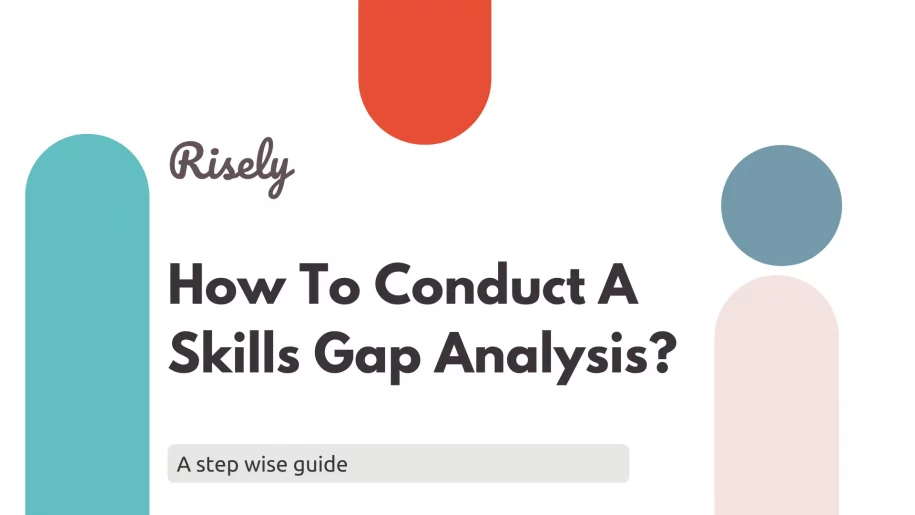How to Conduct a Skills Gap Analysis? Free Template
Did you know? Skills agility is critical to success in the era of AI. However, most large-scale companies are not ready with wide upskilling programs that can transform their workforce across the organizations. Very few of these upskilling programs reach the activation and measurement stage (less than 5%), as per the LinkedIn Workplace Learning Report. The root of this whole process lies in effective skill gap analysis. If the gaps are not measured effectively, you can do little to ensure they are filled before they start hurting. And that’s not all. Analyzing and working on skill gaps is a critical factor in determining the success of an organization’s L&D function. According to the same report, 87% of L&D professionals believe they can positively impact business by addressing skill gaps in the workforce that enable progression and internal mobility. So, it’s not just a good-to-have; solid skills gap analysis is the core of everything an L&D team must do!Understanding Skills Gaps & Skills Gap Analysis
🎓 A skill gap refers to the difference between an organization’s or individual’s skills and the skills needed to perform a job effectively or meet future demands.
Skill gaps occur at various levels, including individual, team, department, or organization-wide, and impact your performance, competitiveness, and ability to adapt to changes in the market or industry. Skill gaps are a constant source of trouble. It’s not a one-and-done job! For instance, LinkedIn reports that 25% of job skill sets have changed since 2015.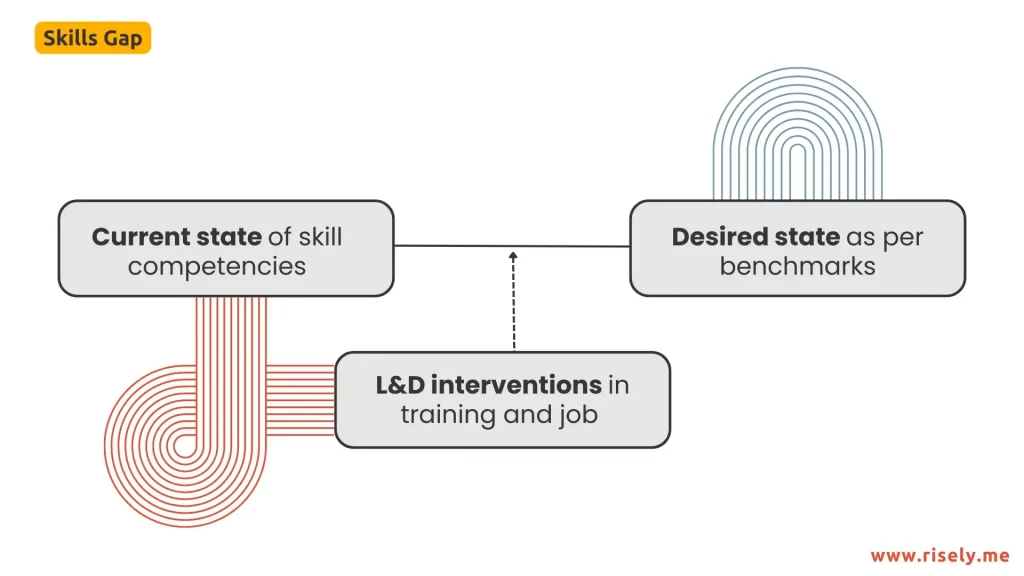
What is a Skills Gap Analysis?
📍 Skills gap analysis is a process that helps you identify the gap between the skills and competencies required for a particular job or industry and the skills possessed by your current workforce.
It involves assessing the skills, knowledge, abilities, and qualifications needed for effective job performance and comparing them with the existing skill set of employees. Further, you can design interventions (and integrate them within your L&D strategy) to overcome these gaps.What Does a Skills Gap Analysis Help You With?
A skills gap analysis aims to identify areas where there is a shortage of skills or a need for additional training and development. But that’s not all it can do. Benefits of skills gap analysis include:Train the right people on the right skills
Skills gap analysis lets you identify the learning and development needs of teams and individual employees in your organization so that you can design learning and development that accurately matches those needs.Create talent pipelines and internal mobility
Further, you enable internal mobility by preparing a pipeline of employees for succession and progression, which in turn enhances motivation and job satisfaction.Develop a competitive edge
Ultimately, skills gap analysis creates a competitive edge by methodically filling up skill and competency gaps that leak performance and productivity.Smoothen new talent hiring
Streamlines overall talent acquisition processes by identifying skill needs at the departmental level through compelling job descriptions and assignments of responsibilities.Make performance measurement objective
It improves performance management processes by creating a standardized understanding of what a particular skill/competency means and what the different levels of competencies look like. It also enables proper measurement of current and desired states of skill development and cutting out bias.Support impactful L&D functions
Skills gap analysis makes L&D teams more cost-efficient by ensuring that learning and development initiatives focus on the right areas. Benchmarking at different stages of the process simplifies tracking business impact.Grab your free copy of Risely’s skills gap analysis framework now!
Inside you’ll find an easily adaptable template to track the skill needs of your team effectively.
Examples of Using Skills Gap Analysis
Combating turnover by focusing on managers
Cedars-Sinai Health Systems presents an interesting case of handling the skills gap. As a healthcare company, you would expect skill gaps to exist in functional areas. However, the problem was something else; they needed to solve to acquire and retain talent better. Cedars-Sinai focused on enhancing workplace health and enabling managers to do it effectively. People managers are critical factors in employee satisfaction and health. If they are not prepared, managing the well-being of employees becomes troublesome. To combat the high levels of stress and burnout among staff, the organization decided to revamp its wellness initiatives. The program focused on turning managers into change agents through additional training and support. This included creating engaging wellness programs, empowering managers to champion wellness, and increasing resource access. Resultantly, they were able to cut down on absenteeism and turnover.Building for a future focused on skills
In a study by Springboard, most executives (42%) agreed that skills have a shelf life of 3-5 years, pointing to the need for consistent analysis and action toward skill gaps. HSBC, the financial services giant, has effectively used skills gap analysis to prepare for future needs and cut down redundant competencies from the team. They also aimed to reduce human interventions in the skill development and redeployment processes. What if employees could upskill and move into an agile organization independently? This question laid the framework for HSBC’s workforce agility platform. As a result, they designed a democratic skill platform that serves not only the needs of the present but also prepares for the future with its skill marketplace.How to do a Skills Gap Analysis for Your Team?
Conducting a skills gap analysis involves multiple steps. The first is understanding where you stand presently and where you want to be. The rest of the exercise is about better understanding this difference and creating a pathway to bridge this gap.What’s the scope of a skills gap analysis?
Before embarking on the steps to conduct a skills gap analysis for your team, let’s first understand the scope of the analysis. As we saw in the learning and development strategy, there are two levels.Team skill gap analysis
At the team level, a skills gap analysis reveals missing skills and competencies compared to the overall team objectives and needs. It focuses on a collective level with the specific context and challenges of the team in mind. The primary factors to think of here include:- What skills would be needed in the future? Is there any new tech coming up, or are there any projects that would need a newer skill set?
- Is the team able to effectively collaborate with other teams?
- Are communication abilities and interpersonal dynamics strong?
- Are there any overlaps or deficiencies in the skill profiles of the team members?
Employee skills gap analysis
On the other hand, the other way considers skill gaps at an individual level. Here, the focus is on ensuring the employee has the skills to effectively complete their job responsibilities and progress to the next stage. Personal and professional ambitions became a critical factor here, while the earlier level was more concerned with strategic objectives. A few questions to address here include:- Does the employee have all the skills and competencies to ace their role? Do they have the skills needed to move on to the next stage?
- Do they have any skill gaps in specific areas, such as functional, people, and technical skills?
- What skill gaps are highlighted in their performance reviews? Has there been progress in those areas?
- What is the employee’s vision for their long-term job role and responsibilities?
- Where does the employee’s skill profile fit within the team/organization?
The 7-step Skills Gap Analysis Process
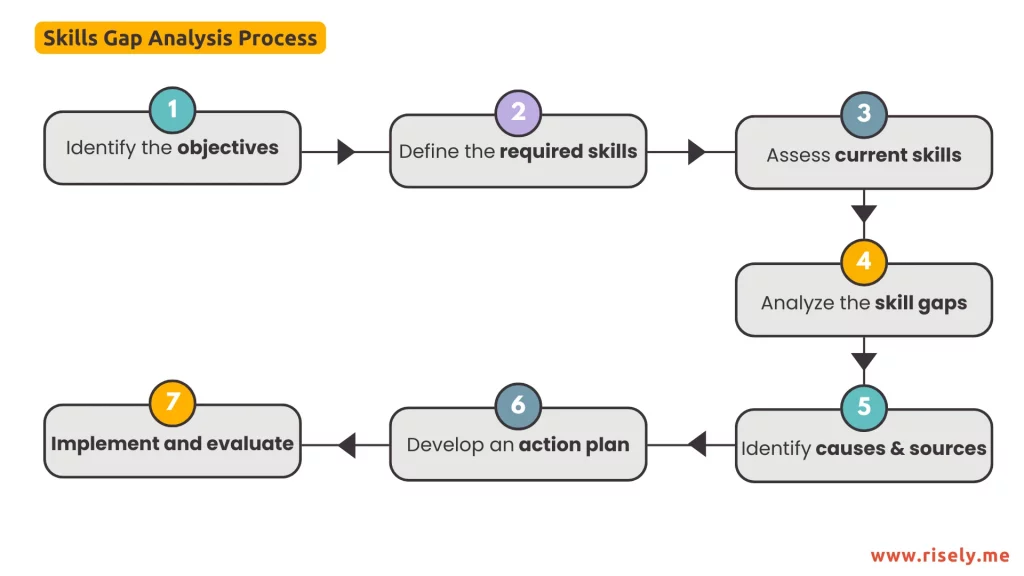
#1 Identify the objectives
The process of conducting a skills gap analysis starts by defining the scope and goals of a skill gap analysis. You will need to clarify:- The level of the exercise: Is it for the entire organization? A particular team? A few individuals due to their performance reviews? Determine the scope as we discussed in the previous section.
- The goals of the exercise: Next up, understand the short-term and long-term objectives where this skills gap analysis can help. Are you conducting a skill gaps analysis to implement a new learning program? Or is it to build skills against a possible change in tech shortly?
Who are the stakeholders in the skill gap analysis process?
They include senior leadership, like the C-suite, who provide strategic vision and approvals to the L&D function. They also include the wider HR function, like recruitment and succession planners, who are impacted by and influence this process. The team managers and leads would be instrumental in conducting the analysis (think performance reviews, surveys, and conversations they need to have to provide insights on skill levels). Lastly, individual employees are also critical, as their answers inform your analysis. Moreover, if you have in-house subject matter experts, they act as an important block in the process as they are critical in developing meanings and benchmarks for particular skills.#2 Define the required skills
In the second step of the skills gap analysis, you will need to define and break down skills into clear definitions. The process starts with understanding particular job functions and the skills they need. You can use job analysis techniques to break down roles into specific competencies.💡 A skills inventory includes a list of all skills assessed, categorized by technical, behavioral, and managerial skills as per job and functional responsibilities within an organization.
How is a job analysis done to create your skills inventory?
In a snapshot, we’d have to take these steps:- Collect job information: You can do this through surveys and questionnaires answered by the marketing managers. You can also add insights using observation and reports from supervisors. It primarily includes an account of the responsibilities, the skills and knowledge needed to complete those, the challenges encountered during this, and ultimately, understanding what success looks like. You should also analyze the existing job descriptions to get a better view.
- Identify key tasks and responsibilities: This step essentially focuses on noting the results from our observation.
- Define required skills, competencies, and tools: What does a person need to know to effectively do everything highlighted in the previous step? Your answer makes up this step. For better processing, you can split these competencies into people and functional areas.
- Validate and refine competencies: Share the identified competencies with stakeholders, including HR, current Marketing Managers, and department heads, to validate and refine the list. Map each competency to specific tasks and responsibilities to ensure alignment and relevance.
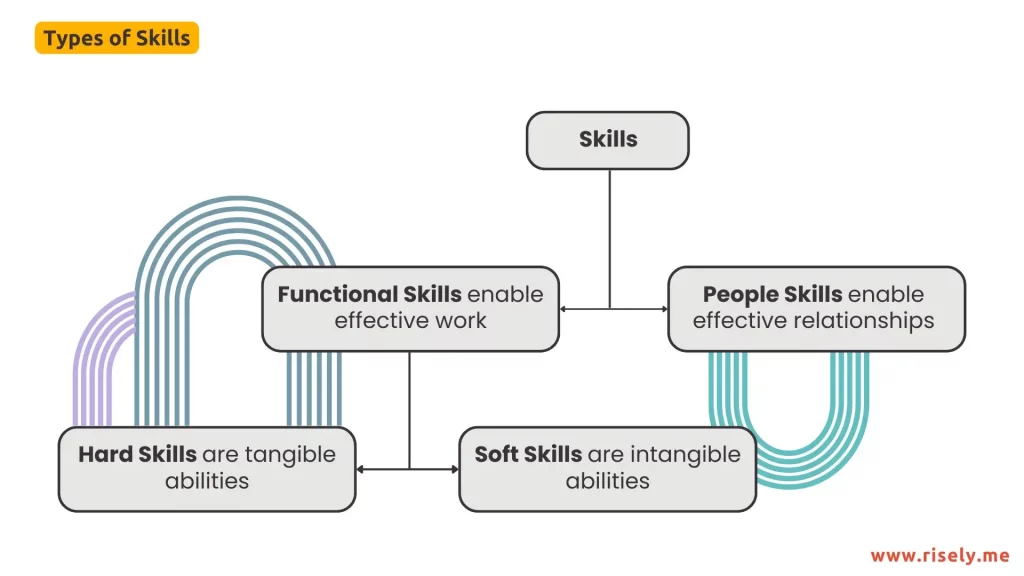
#3 Assess current skills
Once you have curated the skills needed for a particular job, you will assess the current skills present in your organization at a team level and an individual level. Skill assessments take many forms. Some of the most common methods of skill assessment include:- Skills matrix: Create a skills matrix to map out each team member’s skills and competencies. This matrix will identify skill gaps and areas where additional training is needed.
- Self-assessments: Distribute self-assessment surveys in which team members rate their skills and competencies. It provides insights into individual perceptions of strengths and weaknesses. Risely offers such assessments for leadership skills that you can start for free.
- Competency-based evaluations: Use performance reviews to assess team members against defined competencies and job requirements. Evaluate how well each member meets or exceeds expectations in their role.
- Feedback from supervisors and peers: Collect feedback from supervisors and peers about each team member’s skills and performance. This 360-degree performance review provides a well-rounded view of each individual’s capabilities.
- Competitor analysis: Analyze the skills and capabilities of competitors’ teams to identify areas where your team can improve or innovate.
#4 Analyze the skill gaps
Based on the data collected in the previous steps, the analysis begins! A few very interesting methods of visualizing skills gaps for your team are: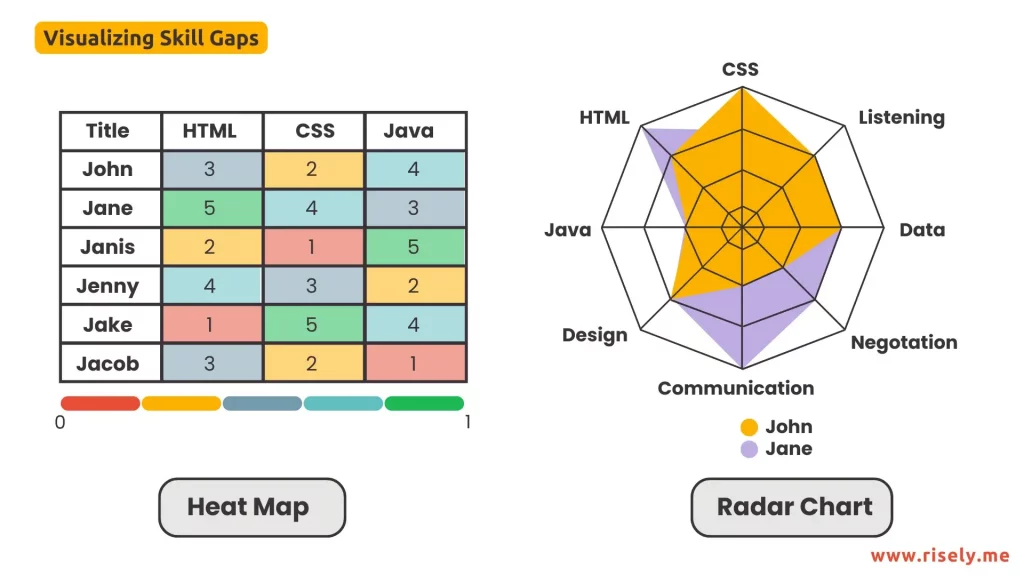
- Matrix Layout: Organize skills in rows and team members or departments in columns (or vice versa).
- Color Coding: Use color gradients (e.g., red for low proficiency, yellow for moderate proficiency, green for high proficiency) to represent the proficiency level in each skill.
- Represent each skill as an axis radiating from a central point.
- Plot each team member’s proficiency level on the corresponding axis.
- Connect the data points to form a polygon, representing each individual’s skill profile.
What do breadth and depth mean in skills gaps analysis?
When you are discussing skills gap analysis, consider the breadth and depth of skill gaps. To create valuable employees, you should consider the breadth (variety of skills lacking) and depth (extent of deficiency in specific skills) of skill gaps.- Breadth Analysis: Identify skills that are lacking across multiple team members or departments. Highlight skills that are crucial but consistently rated low across the board so you can work on them.
- Depth Analysis: Focus on skills with proficiency levels below desired standards. Prioritize skills that are critical to the team’s and organization’s success.
#5 Identify causes and sources of gaps
Once you have identified the significant skills gap, the next question is, why do they arise? Without understanding the causes and sources of a skill gap, you cannot create an action plan to address them effectively. Studies by Springboard show that as many as 70% of leaders feel the presence of skill gaps in their organizations. Looking closer into the skill gaps, a large number of executives surveyed point toward data analysis, project management, and AI/ML-related skills, which have become increasingly relevant with changing technology. However, technical advancements do not create implications only for hard skills. The same survey pointed toward a higher need for cognitive skills across companies. As machines take over more routine jobs, the spontaneity that erupts from thinking, decision-making, and effective communication becomes scarce. Skills gaps arise due to both internal and external factors. For instance, a change in technology can change the skill needs of your team and thus create a skill gap. Alternatively, high turnover among a particular team in your organization might deprive you of those skills. A few common causes of skill gaps include –- Changing Industry Standards
- Competitive Landscape
- Customer Expectations
- Emerging Technologies
- New Regulations
- Lack of Learning Culture
- Resistance to Change
- Ineffective Leadership
- Inadequate Feedback Mechanisms
- Limited Training Budgets
- Misalignment with Goals
What are the methods of identifying these causes of skill gaps?
The first part of doing this is the root cause analysis. Understanding the root causes helps you design targeted interventions that close the gaps and prevent them from recurring in the future. One way of doing this is the 5 Whys analysis. It helps you figure out the cause of a particular problem by repeatedly prompting “why.” Another way of doing this is the fishbone analysis or diagram, which helps you categorize sources of gaps into categories such as people, processes, technology, and environment and tackle them accordingly. While trying to find the causes of skill gaps, keep the Pareto principle in mind – list the top causes that explain the maximum skill gaps.Grab your free copy of Risely’s skills gap analysis framework now!
Inside you’ll find an easily adaptable template to track the skill needs of your team effectively.
#6 Develop an action plan
As we discussed at the closing of the last step, some reasons contribute to big skill gaps in your teams. These are the big ones that you should tackle first. Similarly, once you have identified the causes, list all of them in order of priority. Two critical factors you should consider while addressing these are the criticality of the cause and ease of handling it. Based on this, create SMART goals for your team in the short and long term to address these areas. Also, think of the resources (i.e., the time, budget, physical spaces, people) needed to accomplish these L&D objectives. The ultimate face of your learning interventions can vary depending on the skills you focus on. It’s also great to be in tune with the trends. For instance, about half the organizations surveyed by LinkedIn look forward to including microlearning in their routines. Would that be effective for yours, too?What are the common strategies used to overcome a skills gap?
Well, first, will you rework your existing talent or hire fresh? Once this question is answered, we move. As per trends highlighted by Springboard, most leaders (63%) think of upskilling as the primary approach toward dealing with skill gaps. Another major portion (58%) prioritizes hiring fresh talent with the required skills.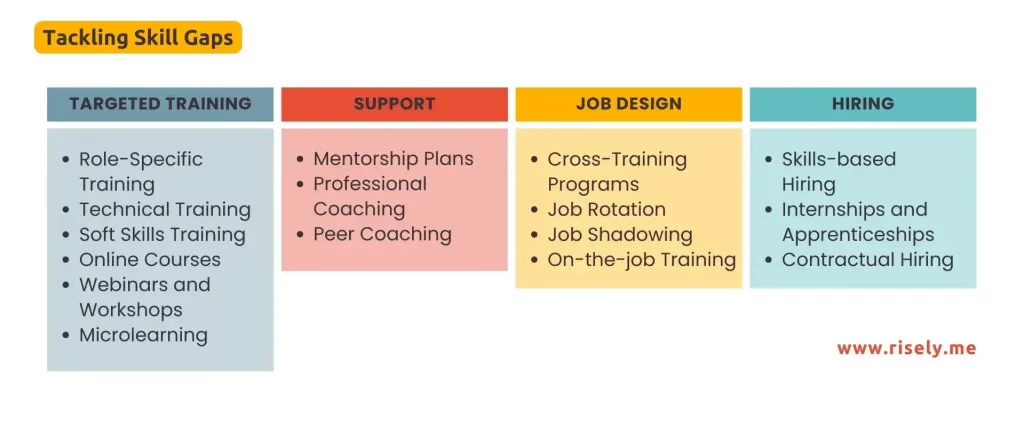
Hiring and talent acquisition
This is the way to go when you need fresh talent, and your existing pool does not have the bandwidth or interest to take up more. You can hire experts to get going quickly or offer internships and apprenticeships to develop the talent in-house and support the team’s needs.Targeted upskilling and reskilling programs
These will include customized learning programs for skill needs delivered through training methods like lectures, videos, or handbooks. Mentorship and coaching employees are viable options to support skill development as well.Job redesign
Sometimes, you can modify the job roles and responsibilities to enable training for particular skills, such as changing assignments, job rotation, or on-the-job training programs. Job shadowing is another effective technique for overcoming skill gaps in individuals on your team.#7 Implement and evaluate
Now, we are getting closer to action. As you have effectively understood and analyzed the skill gaps in a team until now, you can pick suitable training methods and apply them according to your organization’s needs and context. You should do this in collaboration with your team’s wider L&D strategy. During the implementation stage, ensure that goals are clear and follow the SMART criteria. Additionally, build ownership in the L&D department to ensure that the ideas are applied and evaluated effectively along the right metrics. Remember, training does not end with planning it out. That’s just the start. You need to ensure effective implementation, track the progress and feedback, and return to the start with learnings to improve the process. Toward the end of the process, use pre- and post-training evaluation scores to judge the program’s effectiveness. The wider business impact and employee feedback will also help you. Use these insights to refine future skill gap analyses and development programs.Conclusion
In conclusion, conducting a skills gap analysis is essential for the growth and development of your workforce. It helps identify gaps in skills, knowledge, and competencies within your organization and provides an opportunity to bridge them. With technology advancing at an unprecedented rate, staying ahead of the curve is essential to keeping your workforce up-to-date with relevant training and development programs. Use our skill gap analysis template to thoroughly analyze your organization’s skill gaps and create a plan of action that ensures long-term success. Don’t let the lack of skills hold you back. Start bridging the gap today!Grab your free copy of Risely’s skills gap analysis framework now!
Inside you’ll find an easily adaptable template to track the skill needs of your team effectively.

